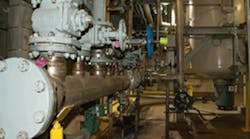Chemical Safety Board Uncovers Flaws at the DuPont Insecticide Plant in La Porte, Texas
On Nov. 15, 2014, nearly 24,000 pounds of deadly methyl mercaptan escaped in the middle of the night through two valves in a poorly ventilated manufacturing building of DuPont’s insecticide plant in La Porte, Texas.
In one area of the plant, operations personnel attempted to clear blocked piping. Later in a different area, two workers opened valves in response to what they believed was a routine, unrelated pressure problem. The two workers were killed when liquid methyl mercaptan drained from the open valves, filling the room with toxic vapor. One of those workers made a distress call, and two additional workers died responding to that call.
The CSB unanimously approved investigators’ draft findings and recommendations at a public meeting Sept. 30 in Houston, not far from the plant. The board also released an animation based on the team’s findings, showing how the fatal accident occurred.
“DuPont has long been regarded as a safety leader in the chemical industry, but this investigation has uncovered weaknesses or failures in DuPont’s safety planning and procedures,” said CSB Chairperson Vanessa Allen Sutherland. “These interim recommendations lay out what the company at its La Porte facility should do to protect workers and the public."
Days prior to the accident, water had mixed with liquid methyl mercaptan in piping. Due to cold weather in the Houston area, this mixture formed a solid material called a hydrate, which blocked the piping. A DuPont technical team eventually developed a plan to clear the blockage by spraying hot water onto the pipes, melting the hydrate.
On Nov. 15, operations personnel worked through the night attempting to clear the blockage. Following a failed start-up, workers paused to take a break. But during that break, the plant started to experience a different problem – high pressure in other piping.
DuPont had long-standing issues with vent piping to an incinerator installed in 2011. To deal with these problems, daily instructions had been provided to operations personnel to drain liquid from these pipes, which were located in another section of the plant. DuPont’s instructions did not specify additional breathing protection for this task.
On the night of the incident, not realizing the original blockage was cleared, workers went to drain the other piping. They did not know that high pressure in that other piping was related to the fact that liquid methyl mercaptan was once again flowing through the original, now unblocked pipes.
“Neither workers nor the public are protected by DuPont’s toxic gas detection system,” investigators said. The building where the workers died was not equipped with an adequate toxic gas detection system to alert workers to the presence of dangerous chemicals. Also, two rooftop ventilation fans were not working, despite an “urgent” work order written nearly a month earlier. Investigators said even working fans probably would not have prevented a lethal atmosphere inside the building due to the large amount of toxic gas released.
The La Porte incident marks the third CSB investigation into a fatal accident at DuPont plants in the past five years. One worker was killed in 2010 when a steel hose carrying phosgene gas burst at a Belle, W.Va., plant. Later that year, a welder perished in an explosion at a Buffalo, N.Y., facility.
A CSB team led by Investigator Dan Tillema spent seven months on-site conducting the investigation and will work to address additional significant process safety issues before the board issues a final report. DuPont has agreed to address the proposed CSB recommendations as part of its plan to safely restart the facility. Among the investigators’ main recommendations:
- Perform inherently safer design review.
- Ensure the manufacturing building is safe for workers.
- Provide relief system design that is safe for workers and the public.
- Complete more robust process hazard analyses.
- Assure active workforce participation.
- Promise public accountability and transparency.
The DuPont La Porte plant was once a leader in applying inherently safer design. It is well known for pro-active changes made to the facility after the devastating Dec. 3, 1984, accident in Bhopal, India.

